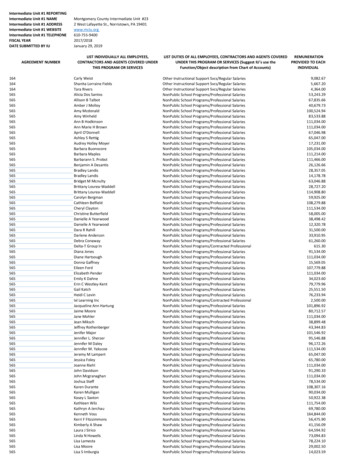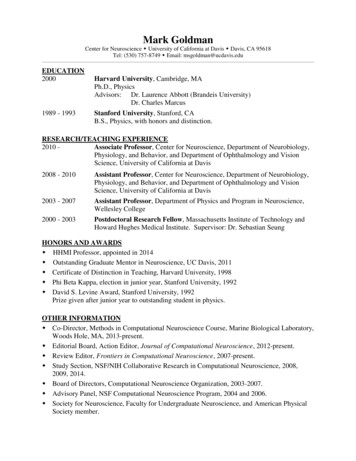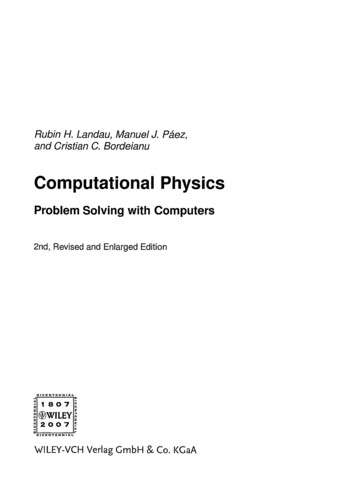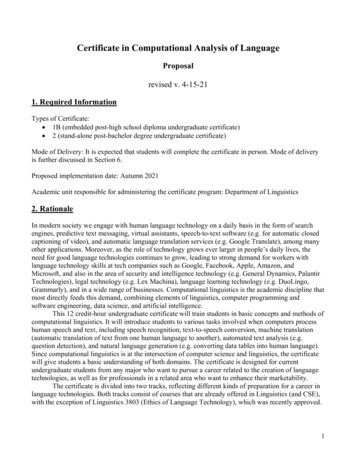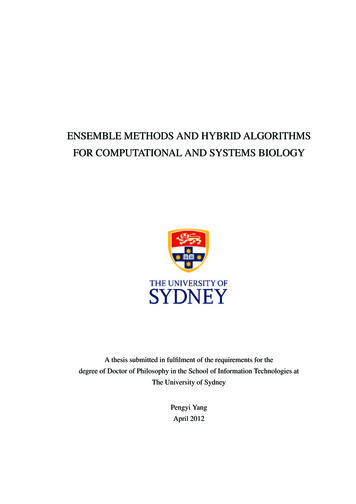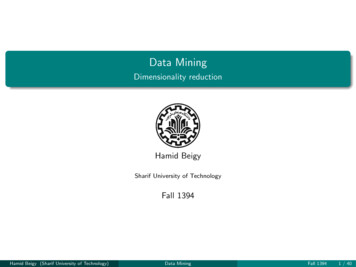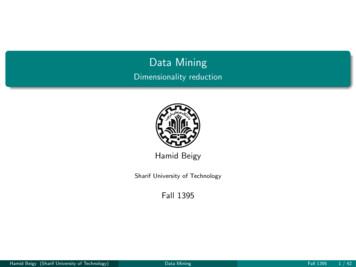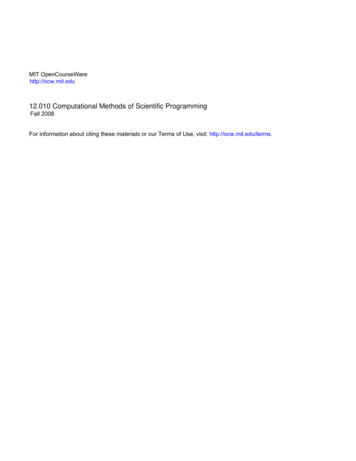
Transcription
MIT OpenCourseWarehttp://ocw.mit.edu12.010 Computational Methods of Scientific ProgrammingFall 2008For information about citing these materials or our Terms of Use, visit: http://ocw.mit.edu/terms.
12.010 Homework #2 SolutionDue Tuesday, October 14, 2008Question (1): (25-points) (a) Write, compile and run a fortran program that generatestwo tables of the Gamma function. The Gamma function satisfies the following equation "(z) % t z#1e#t dt0where z is the argument of the gamma function and can be complex. (See(See http://mathworld.wolfram.com/GammaFunction.html for information on theGamma function). Gamma functions are rarely computed by directly integrating theequation above. Generally they are evaluated by series expansions.!For one table, table will be generated for z between 1 and 10 in increment of 1 when z isan integer. This table should give values of Γ(z), Γ(z 1/3), Γ(z 1/2) and Γ(z 2/3).For the second table, Γ(z) should be generated for z between -1 and 1 in increments of0.1. Results should be tabulated with at least 6-significant digits.The submission should include(a) A discussion of the algorithms used in the program with rationales for the choices(b) The tables generated by the program and(c) The fortran source code.Solution:The Gamma function can be computed in a variety of ways and the reason for the twotypes of tables (one using integer arguments with specific rational offsets and the otherusing non-integer values is that the methods of computing Gamma functions with thesetwo types of arguments are very different.There are a number of sources of information on computing Gamma functions and theone I like to use (for this and may other numerical functions and applications) is:M. Abramowitz, I.A. Stegun, Handbook of Mathematical Functions with Formulas,Graphs and Mathematical Tables, Wiley, New York, 1970. This book is available onlineat S55.ASP and the specificinformation on Gamma functions is /AMS55.ASP?Res 150&Page 255Specifically for integer arguments we use:"(n 1) n!1.4.7.10.(3n # 2)"(1 3) "(1 3) 2.6789385347077479 (6.1.11)3n1.3.5.7.(2n #1)"(n 1 2) "(1 2) "(1 2) 1.7724538509055161 (6.1.12)2n2.5.8.11.(3n #1)"(n 2 3) "(2 3) "(2 3) 1.3541179394264005 (6.1.13)3nThese equations may be easily coded and maintaining accuracy in the calculation is easy.The only caution is that n! grow rapidly and 13! will overflow integer*4 maximize sizeand so factorials are normally computed as real*8 values."(n 1 3) !
The calculation of Gamma for arbitrary arguments is more difficult because of the slowconvergence of the standard formulas for this calculation. In the home work solution weimplement three different methods for this calculation: Euler's Formula, Euler's infiniteproduct and Series expansion originally published in 1933.Euler's formula 6.1.2n!n z(z % 0,&1,&2,.)n# z(z 1)(z 2).(z n)Euler's Infinite product 6.1.3"(z) lim (z 1 "(z) ze'z . *1 -e&z / n( z )n,n 1)Series expansion 6.1.34 (page 256) 1 "(z) /c k z kk 1!The c k coefficients are in the text (and ocr entries at the bottom of the web page)In the code the equation 6.1.2 was modified so that it could be computed for increasingvalues of n. Using this method, the change in the estimates of Gamma(z) could bemonitored to see if the answer had converged with the desired accuracy. Both (6.1.2)and (6.1.3) are very slowing converging and by experimentation it was found that whenthe increments to the zero 10-6 times smaller than the tolerance set (1.e-6), the series hadconverged to the tolerance. The tolerance is a settable parameter (eps) in the code andthis can be changed to experiment with the accuracy of the code (eg., eps 1.d-7 makesall the entries the same in the output.In the output we also used the extended ASCII table to output the symbol. This mightnot generate the same symbol on all systems.The solution is implemented in HW02 01.f and the results are:% gfortran HW02 01.f -o HW02 01% HW02 01Table of gamma functions of positive n ----ngamma(n)gamma(n 1/3)gamma(n 49Table of gamma functions for non-integer --------Three methods are used here:Eulers formulaGammaEulgamma(n 948385
Eulers infinite productGammaInfAsymptotic series expansion GammaSerTolerance on calculation is0.100E-05zGammaEul(z)GammaInf(z)-1.00 Infinity 10.686288-10.6862850.00 Infinity 0.999999GammaSer(z) 4908-3.722981-4.326851-5.821149-10.686287 4891921.2980551.1642301.0686291.000000Question (2): (25-points).Write a program that reads a file containing text, determines(1) The average and root-mean-square (RMS) scatter about the mean of the numberof characters per word and(2) The average and root-mean-square (RMS) scatter about the mean of the numberof words per sentence. A sentence can end with a period or question mark.The text below is contained in the file Q2 text.txt.The basic analysis of spacecraft tracking data requires relating theposition and velocity of the spacecraft to the position and velocity ofthe tracking system. The coordinate system used in spacecraftnavigation is shown in Figure 1.The basic measurements are of r andits time derivative and sequences of these measurements, combined withknowledge of the tracking station location and equations of motions ofthe spacecraft, allow the position of the spacecraft denoted here bydistance r, right ascension, a, and declination, d, and its velocity tobe determined as a function of time. In addition to knowing thecoordinates of the spacecraft in an inertial coordinate system, thecoordinates of solar system bodies are also needed in this frame.Tracking data collected on spacecraft near planets can also be used toimprove the ephemerides the planets through the gravitationalperturbations of the spacecraft motions.Large combined analysis oftracking data and direct measurements of planets (radar and opticalpositions) are used to generate planetary ephemeredes.Hints:Remember if reads are coded as read(*,'(a)') then the file Q2 text.txt can be re-directed
into the program using:Q2F Q2text.txt where Q2F is the name of the program (you can call the program anyname you like).SolutionThis problem is one of careful booking keeping and thinking about the how to detect endof words and ends of sentences. It is also a case where the example text did not containall possible scenarios and so a good code will check for sentence structures that are not inthe example text. Specifically the punctuation elements that are missing are : ; and ?Only the last of these will have an impact on determining the end of a sentence. Theother element missing was a hyphenated word that straddles a line back (the commonplace the hyphenate). The homework solution does take into account these missingelements. The ambiguous part of the sample text is what to do with the numeric 1 valuein the text. The question asks for character counts, which could be interpreted as onlyletters or letters and numeric values. The homework solution only counts letters and notnumber but either solution is acceptable. It is common when implementing an algorithmto have ambiguous statements about what is needed and one complexity of implementingdifferent possible options needs to be considered.The homework solution reads the text from a file and the name of file is passed in therunstring. The Fortran library function getarg is used to do this. There can be differencesbetween implementations of this function in that in some cases argument 0 is the programname (as it is in C) and in other cases argument 1 is the program name. The C-styleimplementation is used here.The solution is implemented in HW02 02.f and the output is:When only letters are counted:% HW02 02 Q2 text.txt12.010 HW02 02: In file Q2 text.txt there are:Mean chacters per word5.38 with RMS 3.15 inMean words per sentence 27.67 with RMS 15.87 in166 words;6 sentencesWhen the numeric 1 is counted as a character the result is:% HW02 02 test.txt12.010 HW02 02: In file test.txt there are:Mean chacters per word5.35 with RMS 3.16 inMean words per sentence 27.83 with RMS 15.66 in167 words;6 sentencesQuestion (3): (50-points) Write a Fortran program that will compute the motions of a setof particles undergoing mutual gravitational attraction. The program should generate thetrajectories of each of the particles with an error tolerance that is proportional to theseparation of the particles. The program should be able to handle large numbers ofparticles and thought should be given as to how to input the initial positions andvelocities of particles when there are a large number of particles.As a test of your program: Evaluate the trajectories of the 6 particles below with an errortolerance of 1.e-6. (This case is similar to the collision of two Sun-Earth-Moon systems)The integration should be run for 515-days and the positions and velocities at the end of515 days should be included in the output.
The values below give the mass (kg), X and Y position (km) and X and Y velocities(km/s) of the 6 particles to be evaluated.2.0e 30 kg XY 0.0e 00 0.0e 00 (km) VXY 0.000e 00 0.000e 00 (km/sec)8.8e 28 kg XY 1.5e 08 0.0e 00 (km) VXY 0.000e 00 2.857e 01 (km/sec)7.3e 22 kg XY 1.5e 08 1.0e 07 (km) VXY -2.424e 01 2.857e 01 (km/sec)2.0e 30 kg XY -1.0e 09 0.0e 00 (km) VXY 1.000e 01 0.000e 00 (km/sec)8.8e 28 kg XY -8.5e 08 0.0e 00 (km) VXY 1.000e 01 2.857e 01 (km/sec)7.3e 22 kg XY -8.5e 08 1.0e 07 (km) VXY -1.424e 01 2.857e 01 (km/sec)Your answer to this question should include:(a) The algorithms used and the design of your program(b) The Fortran program source code (I will compile and run your programs). If youprogram does not run or takes more than few minutes to run, let me know so that Iwill treat it with caution.(c) The results from the test case above with positions and velocities at the end of 515days. You could also explore the effects of changing the accuracy tolerance onthe results.SolutionThis problem is a N-body orbital problem where the error tolerance on the integration isspecified. Error tolerances of this nature are a fractional error (sometimes called relativeerror) and quantify the ratio of the error to a spatial scale in the problem. These types ofdefinitions are often vague as to the spatial scale to be used. If we look at the initialcoordinates, they are of order 109 km and 10-6 of this scale is 1000 km. In the homeworkimplementation we use as the spatial scale the closest pair of bodies and ensure that theirrelative positions are known to the 10-6 tolerance. After day 490 of the integration, thebodies to come very close together and as a result meeting the 10-6 accuracy requirementbecomes very difficult. We also specify a minimum step size (about 1-second) and whenthe bodies are close, step size smaller than this are needed to maintain the accuracy. Theway we evaluate accuracy is to integrate each time step twice: Once with the nominalstep size and the other in two steps with half the step size. The difference is used to testwhether the step size should be halved or doubled. If the tolerance is not meet, the stephalved and the procedure repeated until we meet the tolerance or the minimum size isreached. If the tolerance is exceeded by at least a factor of 40 the step size is doubled.The reason for the factor of forty is that a 4th order Runge-Kutta integration is used and sohalving the step size should improve the accuracy by a factor of 32. If we did not test fora ratio larger than 32, then the algorithm was bounce back and forth between the two stepsizes. The code does include a counter of the number of times the step is changed at eachintegration step and if this exceeds a tolerance than the iteration is stopped. This limit isreached in the current problem when the bodies are very close to each other.The integrator used in this solution is a 4th order Runge-Kutta algorithm given AMS55.ASP?Res 150&Page 897equation 25.5.20 and is from Abramowitz and Stegun.
Solution to y"" f (x, y, y") for a step in x (time) of h1y n 1 y n h[y"n (k1 k 2 k3 )] O(h 5 )61y "n 1 y"n [k1 2k 2 2k3 k 4 ]6k1 hf (x n , y n , y"n )k2 hf (x n h /2, y n hy "n /2 hk1 /8, y"n k1 /2)k3 hf (x n h /2, y n hy"n /2 hk1 /8, y"n k 2 /2)!k4 hf (x n h, y n hy "n hk 3 /2, y"n k 3 )To implement this integration we need to compute the acceleration (function f) at fourlocations given by the above calculations. Notice also here that this integration is validwhen the acceleration depends on velocity as well as position. While the standardgravitational problem depends only on position, this implementation of the integratorallows to easily added drag type forces the equations if we wanted to. These types offorces could be useful in allowing capture of bodies in the problem.The basic modules in the program are:read runstring – allows the name of the file with body definitions, the duration of theintegration and the accuracy tolerance on the integrator to given in the runstring of theprogram.read nbody – reads the body definitions in the form of mass, position x and y, andvelocity x and y. The implementation in this routine only interprets lines that start with aspace. All other lines are interpreted as comments.report ICS – routine to write out the position and velocities of the bodies are specifiedtimes. A character string is also passed to annotate the type output.int step – this subroutine advances the integration by one time step using the integratordiscussed above.eval step – this subroutine evaluates if the current time is adequate for the precisionneeded and determines if the step size should be increased or decreased.get accel – this subroutine compures the accelerations of all the bodies given thepositions passed in its arguments list. Time and velocity are also passed but these areneeded in the gravitational only model. Drag type forces could be easily added to thisroutine.Animate – this is simple routine that uses VT100 escapes sequences to plot the motionsof the bodies on a 85 by 45 grid. See for example:http://pegasus.cs.csubak.edu/Tables Charts/VT100 Escape Codes.htmlreport error – subroutine that reports IOSTAT errors during the run.The main program calls most of the routines above and loops over time, using thedynamically set time step, until the end time is reached. Because the time step canchange, the last time step may send the integrator across the desired time step and sothere is a check and re-calculation of the time step at the end of the integration.
Communication in the program is through a combination of an included common blockand variables passed into and out of routines (remember on Fortran, pointers as normallypassed to functions and subroutines).The code here needs to be compiled with fortran90 or gfortran because we use the arraymultiplication and addition features of f90. (All these operations would need to be donewith do loops in standard f77). G77 will not compile the current code. F90 is availableon Athena when the add sunsoft command is used (see web page on accessing Fortran onAthena).% ssh -X linerva.mit.eduathena% add sunsoftathena% f90 HW02 03.f -o HW02 03Run the same way as below.The code is implemented in HW02 03.f with include file NBody.h The data file with thetest case is NBody.datThe output of the program as requested in the homework is:% HW02 03 Nbody.dat 12.010 HW 02 Q 03: Initial Conditions At time0.00000 daysBodyMass (kg)PosX (km)PosY (km)VelX (km/s) VelY10.200000E 310.0000000E 000.0000000E 000.0000000E 0020.880000E 290.1500000E 090.0000000E 000.2857000E 0230.730000E 230.1500000E 090.1000000E 080.2857000E 0240.200000E 31-0.1000000E 100.0000000E 000.0000000E 0050.880000E 29-0.8500000E 090.0000000E 000.2857000E 0260.730000E 23-0.8500000E 090.1000000E 080.2857000E 02 animation space removed. 12.010 HW 02 Q 03: Final conditions At time515.00000 daysBodyMass (kg)PosX (km)PosY (km)VelX (km/s) VelY12.000000E 30-1.9270598E 084.6801888E 072.0620740E 0028.800000E 28-3.5578701E 085.7460426E 078.7795577E 0137.300000E 22-3.4892707E 085.1814765E 071.0992686E 0242.000000E 30-3.4720247E 086.5313058E 078.0907099E 0058.800000E 28-2.4315337E 08-6.3023788E 077.9210531E 0067.300000E 22-2.3446172E 08-6.4931289E 073.3496439E 01Smallest step size needed 0.000015 daysClosest approach distance was1.59785E 04 km Bodies 2 and 4(km/s)0.0000000E 000.0000000E 00-0.2424000E 020.1000000E 020.1000000E 02-0.1424000E 02(km/s)3.1375402E 01-1.3151751E 027.8372633E 01-1.8176899E 016.8824102E 017.8189206E 01Notice here that step size gets very small during the close encounters of the bodies. If weend the integration earlier before the close encounter, the step size remains much morereasonable. 12.010 HW 02 Q 03: Final conditions At timeBodyMass (kg)PosX (km)PosY (km)12.000000E 30-2.5155546E 081.9141995E 0028.800000E 28-3.6875847E 08490.00000 daysVelX (km/s) VelY5.5598413E 07-8.9011141E 06(km/s)-4.5449261E 01-1.8474636E 01
1.7902116E 0137.300000E 22-3.6088590E 08-2.1983262E 063.6907956E 0142.000000E 30-3.0404683E 085.3414822E 077.0407737E-0158.800000E 28-3.8601263E 08-4.9591322E 07-2.0268385E 0167.300000E 22-3.8033650E 08-4.0240197E 07-6.8645586E 00Smallest step size needed 0.500000 daysClosest approach distance was9.34087E 06 km Bodies 5 and 6In this case, the smallest step size was 0.5 days.-3.4036630E 015.4071950E 015.9777127E 014.1114941E 01
-1.00 Infinity Infinity Infinity-0.90 -10.570565 -10.570542 -10.570564 -0.80 -5.738555 -5.738547 -5.738555 . tracking data and direct measurements of planets (radar and optical . (you can call the program any name you like). Solution This problem is one of careful booking keeping and thinking about the how to detect end of words and .
